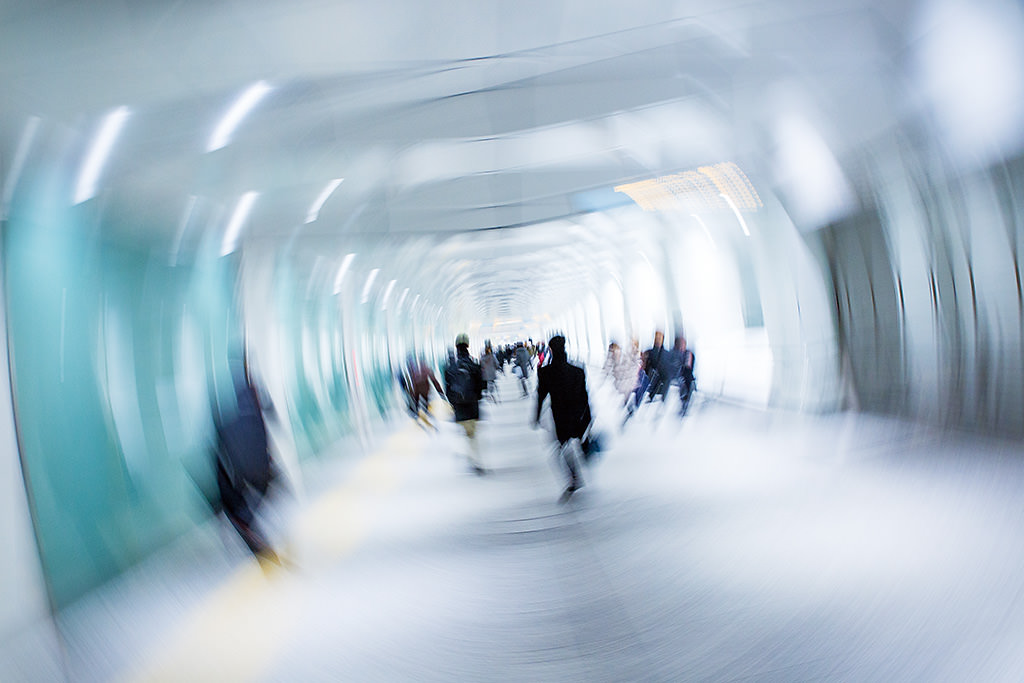By putting our creativity to work, even the most ordinary scenes around us can be turned into interesting photos. As our article about artistic handheld shots of fireworks explored, moving the camera to create intentional blur can be used to create abstract effects to draw the viewer’s attention. Here’s one more similar technique: the art of creating radial blur. (Reported by: Kazuo Nakahara)

1/8 sec.
EOS 5D Mark III/ FL: 24mm/ Shutter-priority AE (f/9, 1/8 sec., EV+0.7)/ ISO 800/ WB: White fluorescent light
Rotating the camera during exposure
This is a shot of an underground passage with working people walking quickly toward the station. The mechanics behind this photo is in fact very straightforward – I simply rotated the camera during exposure at a slow shutter speed. By turning the camera to blur the image intentionally, the image would remain clear at the centre while it becomes blurrier toward the edges, creating an effect as if the viewer is being drawn into the centre of the spiral.
Start by looking for a scene that may turn out intriguing if you create a radial blur effect. Using a wide-angle lens makes it easier to identify the centre of the circle. At the same time, it also creates a larger amount of blur at the peripheral areas of the image. Including people or other subjects in the outer areas also allows the blurry effect to stand out.
While doing so, make sure that the Image Stabilizer function is turned off. Set the shooting mode to Shutter-priority AE, shutter speed to 1/8 second, and take a shot while rotating the camera with respect to the centre of the lens.
If you are using a DSLR camera, looking through the viewfinder and rotating the camera with respect to the centre AF point helps to increase the probability of a successful shot. Also, bear in mind to press the shutter button while you are turning the camera. The result usually does not turn not well if you try to press the shutter button at the time you start turning the camera. It is best to rotate the camera at a relatively faster speed for more beautiful spiral trails.
This technique might seem slightly difficult at first. However, once you get the knack of it, you can apply it anytime and anywhere to widen the scope of your photographic expression.
Point 1: Look for a suitable scene to apply the radial blur effect

The spiral effect appears more intriguing when the main subject is at the centre of the image. Flowers or people make interesting subjects, and this effect goes well with the centre composition.
Point 2: Set shutter speed to 1/8 sec.

The above example was taken at 1/30 second. When the shutter speed is too fast, the amount of blur decreases, and the resulting effect leaves much to be desired. Meanwhile, it would be difficult to take a handheld shot if the shutter speed is too slow. Personally, I find that 1/8 second gives the best balance.
Point 3: Hold the camera firmly and turn carefully

When turning the camera, press your elbows against your body, hold the camera firmly, and turn it with the left hand that is holding the lens as the centre. Also, make sure that the camera is kept close to the body.
About the Author
A monthly magazine that believes that enjoyment of photography will increase the more one learns about camera functions. It delivers news on the latest cameras and features and regularly introduces various photography techniques.
Published by Impress Corporation
Born in Hokkaido in 1982, Nakahara turned to photography after working at a chemical manufacturing company. He majored in photography at the Vantan Design Institute and is a lecturer for photography workshops and seminars, in addition to working in commercial photography. He is also a representative of the photography information website studio9.

































